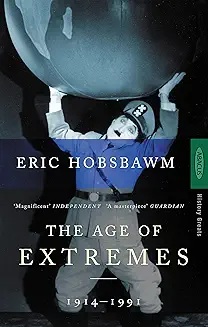Timeless Reads: Revisiting Eric Hobsbawm’s The Age of Extremes and its enduring insights for contemporary political life.

Eric Hobsbawm’s The Age of Extremes remains one of the most influential interpretations of the 20th century, tracing how wars, revolutions, technological leaps, and ideological battles reshaped the modern world. This essay revisits Hobsbawm’s insights to ask a pressing question: how much of this “short twentieth century” still defines the politics of the 21st? From resurgent nationalism and shifting global power to widening inequality and technological disruption, the patterns Hobsbawm identified continue to echo in today’s turbulent moment.
By Newswriters Editorial Team
In an era marked by escalating wealth inequality, geopolitical tensions, and technological disruption, Eric Hobsbawm’s The Age of Extremes: The Short Twentieth Century, 1914–1991 remains strikingly relevant. Published in 1994, the book’s analysis of ideological battles, economic disparities, and global crises offers a historical lens through which to view today’s challenges—trillionaires amassing fortunes surpassing national GDPs, a new space-based arms race, and populist uprisings echoing the unrest of past decades.
Hobsbawm’s Marxist critique of capitalism’s inequalities and his insights into the fragility of social cohesion illuminate the current paradox of unprecedented progress alongside persistent poverty, urging us to question whether today’s extremes will spark renewal or deeper turmoil.
Eric Hobsbawm’s The Age of Extremes: The Short Twentieth Century, 1914–1991, published in 1994, is a masterful historical synthesis that chronicles the tumultuous events and transformations of the 20th century, from the outbreak of World War I to the collapse of the Soviet Union.
As the final volume in Hobsbawm’s tetralogy on modern history, this book stands out for its sweeping scope, Marxist perspective, and ability to weave complex global developments into a coherent narrative. Spanning wars, revolutions, economic shifts, and cultural changes, it offers a compelling, if occasionally polarizing, analysis of what Hobsbawm calls the “short twentieth century,” a period defined by ideological extremism and unprecedented change.
Hobsbawm structures the book in three parts: the “Age of Catastrophe” (1914–1945), marked by two world wars, the Great Depression, and the rise of fascism and communism; the “Golden Age” (1945–1973), a period of post-war economic prosperity and social progress in the West; and the “Crisis Decades” (1973–1991), characterized by economic stagnation, neoliberalism, and the decline of socialism.
This framework allows him to explore the century’s defining tensions—capitalism versus socialism, global North versus South, and progress versus inequality—with clarity and depth. His Marxist lens is evident in his focus on class dynamics and economic structures, yet he avoids dogmatic rigidity, offering nuanced critiques of both capitalist excesses and socialist failures.
One of the book’s strengths is its global perspective. Hobsbawm, a British historian with a cosmopolitan background, deftly integrates developments in Europe, the Americas, Asia, and Africa, highlighting how colonialism, decolonization, and superpower rivalries shaped the century.
His discussion of the Cold War, for instance, not only covers U.S.-Soviet tensions but also their impact on the Global South, where proxy wars and economic policies exacerbated inequality. His analysis of cultural shifts—such as the rise of consumer culture and the 1960s counterculture—adds richness, showing how ideology permeated everyday life.
Hobsbawm’s writing is accessible yet scholarly, blending statistical data with vivid anecdotes. For example, he uses the global spread of jeans to illustrate cultural homogenization, a small but effective touch. His ability to connect macro-level trends (e.g., industrial decline) with human experiences makes the book engaging for both academics and general readers.
However, his Marxist bias occasionally colors his interpretations, such as his relatively sympathetic view of the Soviet experiment, which some critics argue downplays its authoritarian excesses. Additionally, the book’s density—covering so much in roughly 600 pages—can feel overwhelming, and its 1994 publication means it lacks hindsight on post-Cold War developments.
The Age of Extremes remains a landmark work for its ambitious scope and intellectual rigor. It challenges readers to grapple with the century’s contradictions: immense progress alongside devastating conflicts, technological leaps alongside persistent inequality. While Hobsbawm’s ideological leanings may not resonate with all, his insights into the forces shaping our world—capitalism’s resilience, the fragility of social contracts—feel strikingly relevant today, especially in light of contemporary debates about wealth concentration and geopolitical instability. For anyone seeking to understand the 20th century’s legacy, this book is an essential, thought-provoking read.



